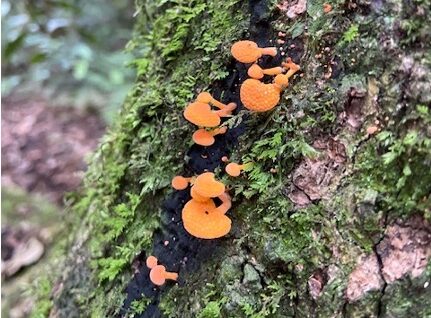Written By Naomi Tutticci
I think about how time is going so fast and how much living there is to do. I’ve also thought that death and life are incompatible. One state is an absence of consciousness; the other is the vibrant and challenging experience of self-consciousness. Looking around me in the natural world I see that life and death coexist, in the one organic vessel. Plants have living tissue (growth) and dead tissue that slowly or sometimes quickly disconnects from the stem or trunk and falls to the ground. The technical term for what happens next is decomposition, the process of organic matter breaking down into carbon dioxide and minerals. Plant debris is also converted into fungi and bacteria by these organisms consuming this organic material and reproducing.
As humans, we are carbon-based organic lifeforms, that on death break down (actively if cremated or passively if buried) into organic and inorganic parts. We become a flourishing ecosystem evolving as decomposition proceeds. A sophisticated and complex decomposition process ends with the production of organically rich soil, beneficial to the surrounding ecosystem. This is life after a natural burial. Pawlett et al., (2024) describe natural burial as an internment process that promotes biodiversity and habitat creation by omitting the use of preservatives in body preparation for burial. Burial containers are sourced sustainably and are biodegradable. Conceptually there are numerous benefits to a natural burial, yet there are still many unanswered questions about carbon sequestration benefits, social legacy and contributions to ecosystems.
Recently I updated my will and power of attorney and prepared my advanced health directive. Thinking about end of life and instructions for death and disposal of my body prompted me to think about how I could contribute to planetary health after death. It was a surprisingly liberating experience finding out I could contribute to the cycle of life and mitigate my impact on soil quality by choosing a more sustainable death. Advanced Care planning is an opportunity to share your preferences for a more sustainable end of life and death with those who you love and who love you, planet included!
References
Pawlett, M., Girkin, N. T., Deeks, L., Evans, D. L., Sakrabani, R., Masters, P., Garnett, K., & Márquez-Grant, N. (2024). The contribution of natural burials to soil ecosystem services: Review and emergent research questions. Applied Soil Ecology, 194. https://doi.org/10.1016/j.apsoil.2023.105200
https://www.qld.gov.au/health/support/my-care-my-choices/advance-care-planning-resources
About the author: Naomi is an avid outdoor enthusiast and weekend warrior trail runner. Stopping and soaking up the view whilst running gives her a chance to catch her breath. Nursing is also part of her DNA and the two are connected by her passion for planetary health. This is expressed often by ‘left field’ thinking as to how as nurses we can reconceptualise our relationship with the planet. The thoughts expressed in this piece are her opinions which are influenced by referenced material and a good dose of living.
